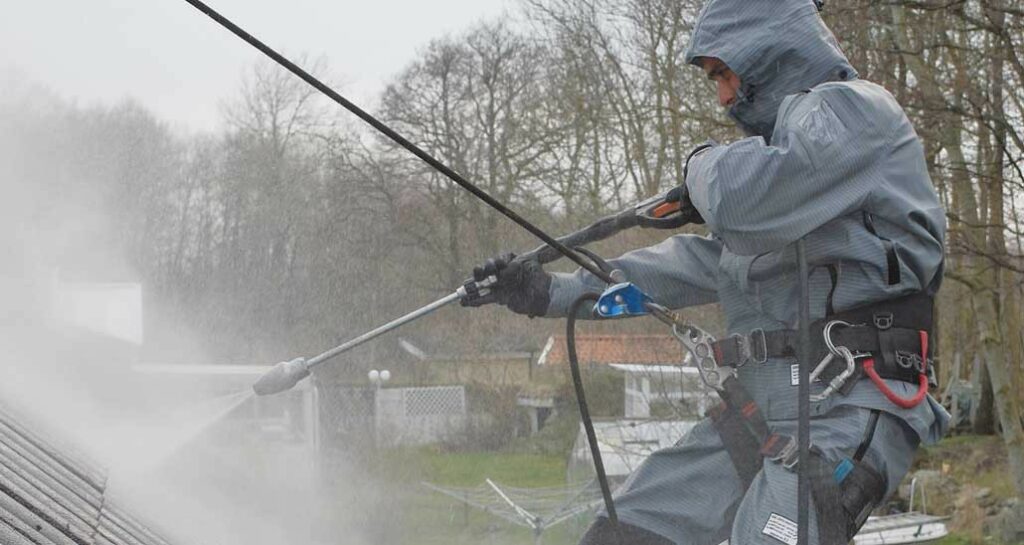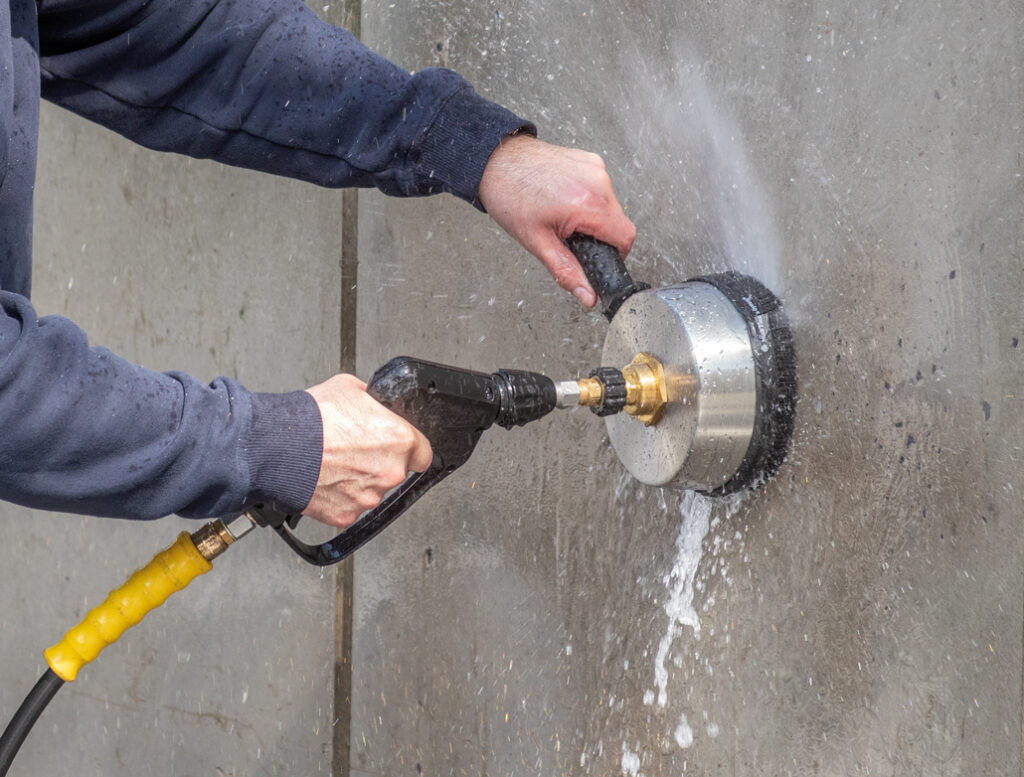

Whether on construction sites, in workshops, or for facade maintenance – high-pressure cleaning has proven to be one of the most effective methods for removing dirt and deposits. By precisely combining pressure, water volume, and temperature, even stubborn contaminants can be removed in an environmentally friendly and economical way. Those who master the basics of high-pressure cleaning achieve professional results and avoid damage to materials or surroundings.
The pressure of a high-pressure cleaner is the key factor in its cleaning performance. The higher the pressure, the more kinetic energy is transferred to the surface. The rule is: stubborn dirt such as paint, concrete dust, or industrial oils requires higher pressure, while sensitive surfaces should be treated with reduced pressure.
In addition to pressure, water flow plays a decisive role. Measured in liters per minute, it determines the amount of water that flushes away dirt and deposits. A high flow rate is particularly useful for large areas, as it reduces cleaning time and improves the result.
Hot water is significantly more effective on oily and greasy dirt than cold water. Therefore, hot-water cleaners are mainly used in industry, food processing, and the automotive sector. Cold-water cleaners, on the other hand, are ideal for water-soluble contaminants such as mud, soil, or dust.
The nozzle determines the shape and intensity of the water jet. Point-jet nozzles concentrate pressure on a small area – ideal for stubborn dirt. Flat-jet nozzles allow uniform cleaning of larger areas. Rotating nozzles combine power and area coverage through a rotating jet pattern.
Typical high-pressure cleaners operate between 50 and 250 bar. While 50–100 bar is sufficient for light cleaning tasks, industrial applications often require pressures above 200 bar. It is important that the pressure can be continuously adjusted or changed via nozzle selection.
Devices with 10–20 liters per minute are suitable for medium-sized applications. High-performance units with up to 42 l/min are intended for very large or heavily soiled areas – for example, in warehouses, depots, or production facilities.
Cold-water devices work at ambient temperature, while hot-water cleaners can heat water up to 150 °C. The temperature should be selected based on the type of contamination: grease, wax, and many organic substances dissolve much better at higher temperatures.
For particularly stubborn residues, special high-pressure cleaning chemicals can be used. These are matched to the material, surface, and environmental requirements. It is essential to use only approved agents and to follow the manufacturer’s dosage instructions.

Permanently installed systems are used where regular, intensive cleaning is required – for example, in automotive workshops, industry, or car wash facilities. They are characterized by durability and low maintenance requirements.
Mobile high-pressure cleaners offer maximum flexibility on construction sites, outdoors, or in field service. They are easy to transport and quick to set up – ideal for changing work locations.

These units are designed for light to medium dirt. Typical applications include garden maintenance, facade cleaning, or vehicle care in private households.
High temperatures make these devices the first choice for oily residues, bitumen, paints, or greasy deposits. They provide deeper cleaning and are more hygienic than cold-water solutions.
The concentrated jet hits the surface with high energy and directly removes dirt – similar to a mechanical scraper, but much gentler and more even.
The combination of pressure and water volume effectively rinses away loosened particles. This prevents residues and minimizes rework.
At very high pressure, the water jet can also remove material – for example, paint, rust, or loose plaster. This is known as erosive cleaning and must be used in a controlled manner.
In industry, high-pressure technology is used to remove oil, grease, metal dust, or production residues. The combination of hot water, high pressure, and chemical support is particularly effective.
After construction work, thorough cleaning is required – whether of concrete residue, mortar, or cement film. High-pressure devices with a high flow rate are the tools of choice.
High-pressure cleaners are indispensable for maintaining building value. Glass, natural stone, or facade panels are cleaned gently – if necessary with soft brush attachments or special nozzles.
From tractors to railway tracks – high-pressure cleaning ensures safety, hygiene, and functionality. Mobile hot-water units are often used in these areas.
High-pressure cleaning is a versatile, powerful process – but only successful when technology, accessories, and application are harmonized. Those who understand the physical principles, device types, and areas of use achieve efficient and safe cleaning results in every sector.
2. When should I use a hot-water cleaner instead of a cold-water device?
Whenever you need to remove oily, greasy, or particularly stubborn organic residues. Hot water acts as a cleaning booster, as it reduces the surface tension of grease and aids detachment.
3. Can a high-pressure cleaner damage surfaces?
Yes – improper use, excessive pressure, or the wrong nozzle can cause paint to peel, materials to be damaged, or glass to break. Always start with low pressure and gradually increase – or use the soft-wash method for sensitive materials.
4. What does “bar” mean on a high-pressure cleaner?
“Bar” is the unit of pressure. One bar is approximately equal to the air pressure at sea level. High-pressure cleaners operate between 50 and over 250 bar, depending on the model – the actual working pressure determines the cleaning effect.
5. Can I use cleaning agents with any high-pressure cleaner?
Only if the device is designed for it. Most professional models have an integrated detergent injection system or an external hose connection. Only suitable, biodegradable agents should be used.
6. How do I choose the right nozzle?
The choice depends on the task: point-jet nozzles for heavy dirt, flat-jet nozzles for surfaces, and rotating nozzles for combined performance. Manufacturers provide recommendations for pressure levels and applications.
| Device Type | Advantages | Disadvantages | Typical Application Areas |
|---|---|---|---|
| Stationary Unit | – High performance – Low maintenance – Suitable for continuous use | – Not mobile – High installation effort | Workshops, production halls, car wash facilities |
| Mobile Unit | – Flexible use – Easy to transport – Universally applicable | – Lower performance in cheaper models – Higher maintenance | Construction sites, outdoor areas, building cleaning |
| Cold-Water Cleaner | – Cost-effective – Energy efficient – Ideal for light dirt | – Not suitable for grease or oil – Lower cleaning effect on biofilm | Private users, gardens, simple outdoor cleaning |
| Hot-Water Cleaner | – High cleaning performance for grease and oil – More hygienic – Time-saving | – Higher energy consumption – More expensive to buy and maintain | Food industry, vehicle fleets, machine cleaning |